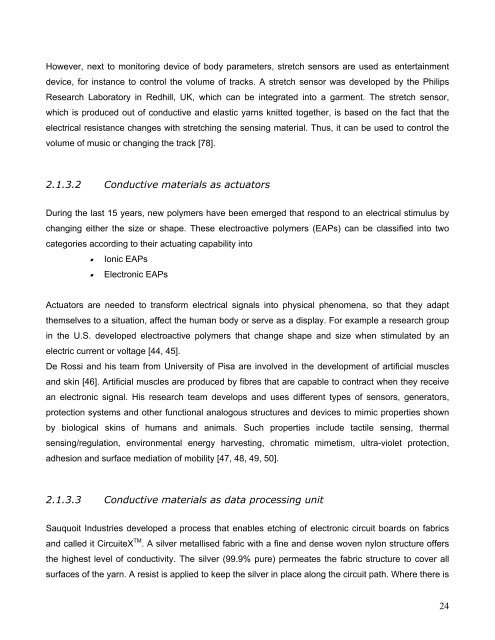Clevertex - Grado Zero Espace Srl
Clevertex - Grado Zero Espace Srl
Clevertex - Grado Zero Espace Srl
Create successful ePaper yourself
Turn your PDF publications into a flip-book with our unique Google optimized e-Paper software.
However, next to monitoring device of body parameters, stretch sensors are used as entertainment<br />
device, for instance to control the volume of tracks. A stretch sensor was developed by the Philips<br />
Research Laboratory in Redhill, UK, which can be integrated into a garment. The stretch sensor,<br />
which is produced out of conductive and elastic yarns knitted together, is based on the fact that the<br />
electrical resistance changes with stretching the sensing material. Thus, it can be used to control the<br />
volume of music or changing the track [78].<br />
2.1.3.2 Conductive materials as actuators<br />
During the last 15 years, new polymers have been emerged that respond to an electrical stimulus by<br />
changing either the size or shape. These electroactive polymers (EAPs) can be classified into two<br />
categories according to their actuating capability into<br />
• Ionic EAPs<br />
• Electronic EAPs<br />
Actuators are needed to transform electrical signals into physical phenomena, so that they adapt<br />
themselves to a situation, affect the human body or serve as a display. For example a research group<br />
in the U.S. developed electroactive polymers that change shape and size when stimulated by an<br />
electric current or voltage [44, 45].<br />
De Rossi and his team from University of Pisa are involved in the development of artificial muscles<br />
and skin [46]. Artificial muscles are produced by fibres that are capable to contract when they receive<br />
an electronic signal. His research team develops and uses different types of sensors, generators,<br />
protection systems and other functional analogous structures and devices to mimic properties shown<br />
by biological skins of humans and animals. Such properties include tactile sensing, thermal<br />
sensing/regulation, environmental energy harvesting, chromatic mimetism, ultra-violet protection,<br />
adhesion and surface mediation of mobility [47, 48, 49, 50].<br />
2.1.3.3 Conductive materials as data processing unit<br />
Sauquoit Industries developed a process that enables etching of electronic circuit boards on fabrics<br />
and called it CircuiteX TM . A silver metallised fabric with a fine and dense woven nylon structure offers<br />
the highest level of conductivity. The silver (99.9% pure) permeates the fabric structure to cover all<br />
surfaces of the yarn. A resist is applied to keep the silver in place along the circuit path. Where there is<br />
24

















